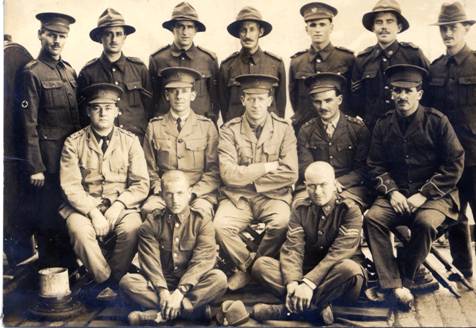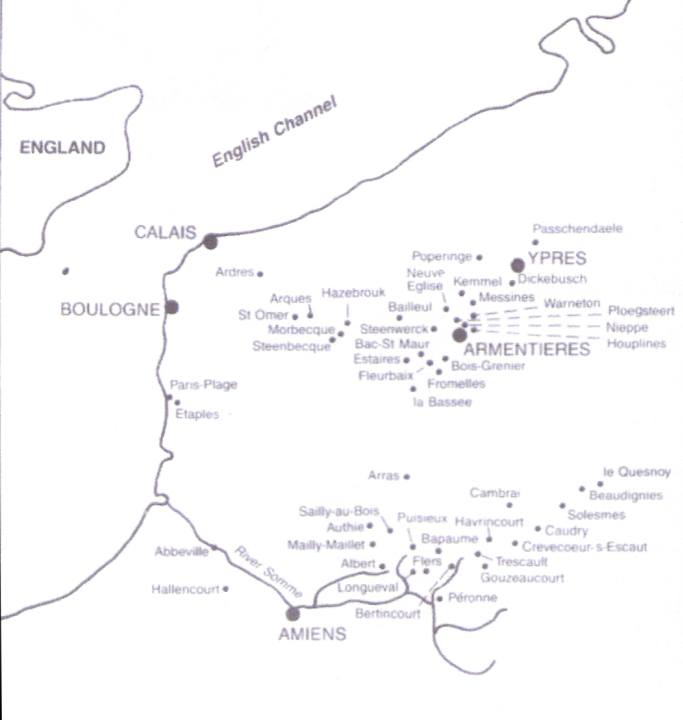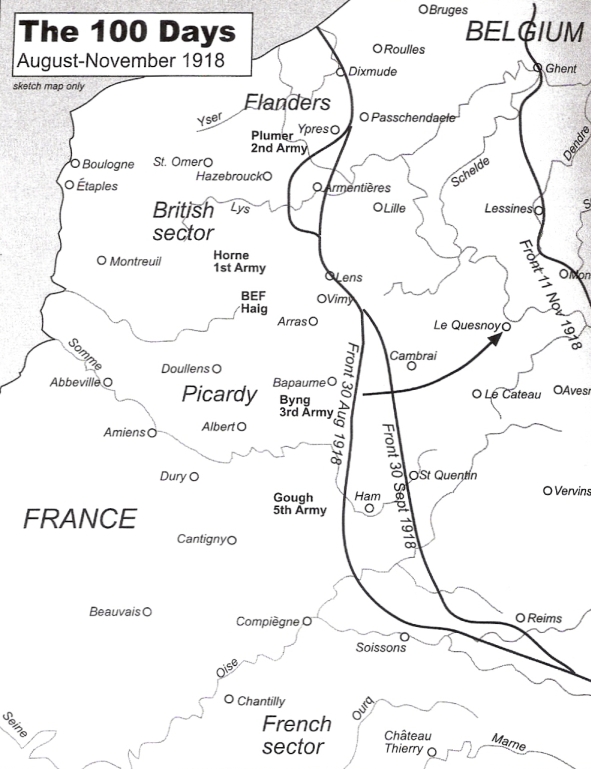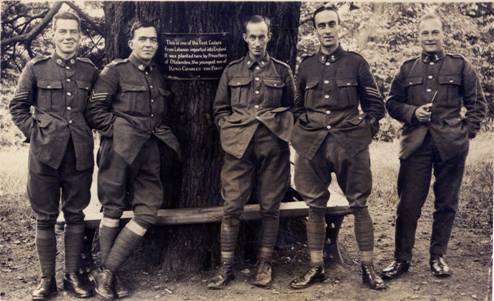The New Zealand Genealogist, Vol 39, No 313, pages 313-318, September/October 2008
Working with the YMCA Team in World War I
By
Simon and Robin Johnson
Our grandfather and father, JOHN JOHNSON, was detached from the Otago Mounted Rifles in 1917 to work under Major JAMES HAY as a study circle leader in the YMCA's various huts
within the different regimental groups of the New Zealand Division in France. Huts
appears to be an euphemism for any YMCA hut or enampment within an army group where YMCA facilities were provided. The work involved visiting the regimental YMCA groups and getting study circles started, encouraging existing study circles, and organising lectures and reading matter.
The YMCA in World War One
Apparently most of the allied armies on the western front had YMCA units attached to them for recreational, educational and comfort services. They organised an accommodation club in London for New Zealand soldiers and had field services in France gathered round the "YMCA Hut" concept. In charge for the New Zealand Forces in France was Major JIM HAY (later SIR JAMES HAY).
In Egypt, Kinloch (2005) says that the Mounted Rifles were quartered in Zeitoun Camp in 1915 and that the local secretary of the YMCA warned anyone who would listen that Cairo was full of 'terrible temptations'. Regimental chaplains set up a large YMCA tent as a hopeful counter-attraction to the 'evils' of the nearby city. Writing materials were provided free of charge, and church servives and weekly concerts were held there. A post box was kept in the tent and sometimes no fewer than a thousand letters were posted in a day. Other drawcards included lectures on aspects of Egyptian archeology given by local scholars
(p.76).
In London, Wright (2005) describes the YMCA facility Most soldiers stayed at the YMCA or the New Zealand Soldiers Club. This, a [soldier] STAYTE declared, was `the best place I struck and the cheapest. The food was splendid and the beds good. Tariff, bed eightpence; breakfast eightpence; dinner one shilling and tenpence. Officers could afford hotels. Many went to the Royal Overseas Officers' Club established in the magnificient building of the Royal Automobile Club. The stiff civilian entrance fee of 50 guineas was waived
(p.62).
The higher-ups in the New Zealand Division in France recognised the need for enhanced support services after they came out of the Somme in late 1917.
(Pugsley, p.256). General RUSSELL [the commanding officer] called together the Soldiers and Workmens Council . This was a meeting chaired by RUSSELL of the senior officers of the Division, the YMCA representative, JIM HAY, and selected veterans representing the views of the men. A free discussion took place and it was recognised that morale was low in the Division and dangerously low in neighbouring British divisions. The solutions were seen in a combination of improving the local conditions and seeing to the welfare of the men, and also telling the men what they were fighting for. ORMOND BURTON was one of the veterans at the meeting I came away with a profound admiration for General RUSSELL, for his directness, a certain simplicity and sincerity, and very real humility, with devotion to do what he saw as his duty
(Pugsley, p 256).
Pugsley goes on; The resurrection of the Divisions' morale and spirit was set in train. The basis was as it had been after the Somme - the care and welfare of the men. Dry accommodation, clean straw for bedding and hot food, the divisional theatre, talks, debating societies, extra blankets for units with older men, the unofficial furlough scheme, leave in England and Paris, sports days and Christmas day with puddings and turkey, all played their part…RUSSELL cajoled and nursed his division back to health
(pp. 256-7).
Private JOHN JOHNSON joined up in April 1915 and was called up with the Sixth Reinforcements for the New Zealand Division, as an ordinary infantryman. He was an economics graduate from the University of Otago. After 3 months drill in Trentham, the reinforcements sailed on the Willahra for Egypt.

Photo 1. Graduates of Otago University among the Sixth Reinforcements on board the Willahra, 15 September 1915. Back row, left to right: Thomson; Aitken; Gilmer; John Johnson; Pitt, McInnes; McKenzie. Middle row, left to right: Mitchell; Earls; Harrison; Withers; Watt. Front row: Duke; Maunsell.
JOHN JOHNSON had a post as signaller which made the trip more interesting. Some weeks near Cairo on the Suez Canal gave excellent opportunities of seeing its sights and its civilisation he says.
Then towards winter the group set sail for Gallipoli, via the Island of Lemnos, landing in the dark to join the main body of New Zealanders who were hanging to ANZAC Heights by a straw. JOHNSON wondered why the Turks did not drive the enemy off. On leaving Lemnos, he said in a letter to his sister, MISS HANNAH JOHNSON:
For some days we were expecting a move from Lemnos, as the 4th Australian Brigade had left for ANZAC. On November 8th, Wellington and Canterbury Brigades sailed on the "Osmanich" and the next Tuesday we and the Auckland brigade broke camp, and by noon we were also on board her in Mudros Harbour, 1000 odd of us, tight packed as usual in these parts and soon were steaming on a calm sea outwards....A hollow sort of iron tank steam-barge came out and took our whole battalion in to Williams Pier on the North Beach, which is north of ANZAC Cove....the Turks shell ANZAC beach even at night, from Gaba Tepe, with a gun known as 'Beachy Bill'
(Original letter in McMillan Library).
The Division was relieved before Christmas, and returned to the Greek island of Lemnos, and then back to Egypt. JOHNSON was invalided out to Cairo after Gallipoli with enteritis and then rejoined the Division when they sailed for France. The Division reached France in the spring of 1916 and found its role was to help man the trenches, part of the long line along the borders of Belgium and France known as Flanders (see map). In the Battle of the Somme the first casualities were experienced.
JOHN JOHNSON says in his memoirs: My friend CAPTAIN GARFIELD STEWART applied for me to be transferred to his force the Army Supply Company which kept me rather in the rear near headquarters and I had interesting work receiving and giving out rations to a whole brigade
[The family always understood that he got the job because he could speak French and could deal with the local tradesmen]. This gave me some spare time also the use of a bicycle and I explored quite a bit. I also managed a 4 day trip to Paris (by train) and another to Rouen with its historical connections. Living near HQ I got contact with the YMCA central control under JIM HAY [later Sir JAMES HAY], a wonderful organiser – as he proved in his business after the war [Haywrights]. The YMCA had huts for soldiers in the NZ Division in conjunction with the chaplains of the various regiments. I spent my spare time promoting study circles, lectures and reading matter.

Map 1 Geography of Flanders and Picardy
Eventually Mr. HAY got me released from strictly military duties and attached to YMCA HQ continuing my earlier occupations. A number of us in the Division, who were pacifists or at least pacifist-minded, formed or rather called ourselves the 'Brotherhood of Men of Goodwill'. This included ORMOND BURTON, LOUIS PHILIPS (a Jew) and a solicitor, JOHN LEE, who later became a writer. This was a sort of reaction against the war and its waste of time and our abilities. We rarely had meetings but we kept in touch as occasion allowed and amongst other things discussed the future of New Zealand and all the things we might do possibly through the YMCA. This did not come off but we later worked for peace through churches and the C.F.S. and the S.C.M. and other institutions. This was in France, but TOM MACKY kept the B.of G.W. ideal alive in YMCA groups in England.
The New Zealand Division was moved about the Western Front to where it was needed. They started in April 1916 in Flanders near the towns of Armentieres and Ypres. In September 1916 they were moved to the area known as PICARDY based around the Somme River, and the town of Amiens. In February 1917 they were moved back to Flanders near Messines. In March 1918 they were moved back to the Somme. In June 1918 they were moved to Authie near Bapaume. They were fighting at Le Quesnoi, well to the east of Amiens, when the Armistice was signed in November 1918.
Working with the YMCA
JOHN JOHNSON was still with the Otago Mounted Rifles in 1916. We have little detail of his movements. His transfer to the ASC took place in November 1917 and before long Major HAY had him transferred to the YMCA. From November 1917 he kept a diary of his activities and we can trace his activities through 1918 until he was invalided out of France. The diary seems to date from his assumption of full-time YMCA duties in the FLANDERS area.
On November 18, 1917 he says he was detached to work with NZ YMCA as organising secretary of the 'Brotherhood of Men of Goodwill' at Vauxhall Hall (near Ouderon). The YMCA secretaries were MR EDMOND and Mr HORNER It was a treat to eat civilised meals united by a table with changes of plates, clean talk and good food and grace!
On the 19th he went up to Dickebusch (just outside Ypres), their centre and store, to arrange literature and to visit the 3rd and 4th Brigade schools at Dominion Camp and the Scottish lines. On the 22nd he visited Poperinghe, just West of Ypres . On the 24th the Hut at Dominion Camp was handed over from two Scots parsons, who apparently did not like colonials. The secretary was Mr EDMONDS and a great party of orderlies; LOO BICKER (cook), Messrs MEADOWS, BERT BUTTER, FRANK RAMSAY and NORMAN GRINLINGTON
. They lived in the "Hut" with their own orderlies. On the 25th of November he noted there were 25 men present for an afternoon tea and a meeting. On the the 29th he visited two ambulance units in 1st Brigade (including THE REV MULLINEAUX).
On 2 December he visited Walker Camp and on the 4th he biked to Boescheppe Village and on the 5th, Kemmel Village. (ARCH STUART just missed a terrific shell outside his Dug at Shrapnel Corner
). On 12 December he gave a talk on 'the War and Democracy' near Shrapnel Corner.(SAM FORSYTH, NZ Engineers) His diary notes that he walked back afterwards in a frost, indicating weather conditions on the frontline. He had a visit from two typical old diggers
, F WILKINSON AND J MCKENZIE. On the 19th he biked down to No 1 Ambulance [study] circle. He wrote; It is bitterly cold. On Xmas day it is miserble and cold, but the evening turned out well - 25 odd men turned up for afternoon tea and we had a special evening with toasts to the King, the Division, Blighty, the Home Folk, Sweethearts and the End of the War!
On the 30th of December he biked up to Shrapnel Corner where a canteen had been established at 'Half Way House', among the guns. Again he recorded his impressions; A great dugout a way down holding close on 500 men. In the afternoon, down the Menin Road to their unit at Lille Gate filled with happy Maoris and Engineers
. FRANK CAMERON is installed at Howe Camp "hut".

Map 2. The 100 Days Offensive, August - November 1918
On 6th January 1918 he attended a lecture by Sir Richard Lodge, Professor of History at Edinburgh on 'Union of Italy and Union of Germany' at Lille Gate Hut. There was a second lecture, on 'Imperial Reconstruction', at 6pm in the Divisional Theatre. He walked to Ypres in snow on the 9th to hear a lecture by Dr MCGRATH in Little Talbot House on 'History of Ypres'. On the 10 th January, he travelled to the stationary hospital at Wisques. His diary continues: January 11th, shopping in St Omer (REV MALDEN); passed through poor old squashed Hazebrouck
[see map]; General WOOD of American GHQ lectured to 1,500 New Zealander in the Divisional theatre; 13th January, tea with 4 Brigade 3rd Otago HH. (Howe Camp) (MR HOMER). He gave a lecture on (presumably on his leave to) 'Paris' at Ypres in the snow. On 19th January he gave his 'Paris Lecture' at Walker camp. The next day he walked to Ottawa camp [of the Canadians].
From Monday 28 Jan to 6th February, he arranged talks for Mr Wm Berry [The enobling aspect of sex relationships
] at Howe camp, Lille Gate, Belgian Chateau, Walker Camp, Dickebusch, Ottawa camp, Scottish Lines and Artillery Lines. On 22 January he visited the following places by Ford truck: Abeele, Cassel, St.Omer, Wisques, Bayenghem, and the Australian Division at Devres and on to Etaples [Coastal Base]. On January 24, he visited Boulogne and on way back passed through Lumbres, Wisques, and Bailleul. On January 30 he visits Remy and the Scottish lines. On 12 February, DR MCGRATH gives a well-received lecture to a packed house at Kenner near Ypres. A new hut is opened under MR HALLIDAY. On the 9th Februay, the Freemasons of New Zealand open a Masonic Gift Hut in the NZFA camp; in presence of MAJOR GENERAL RUSSELL and BRIGADIER GENERAL JOHNSTON. The opening ceremony included dedicatory prayers and a musical programme.
From 14 February he goes on leave to UK; Calais via Cassel Wateau in the Ford car; crosses to Canterbury on the 15th and took the night train to Scotland from Euston. He stays in 'Digs' in Glasgow: On 25 February he travels south through Dumfrieshire to Carlyle, Leeds, Leicester, Nottingham, and back to Kings Cross ( where he stays at the Red Court Hotel, a hotel well known to YMCA secretaries
). On 5 March he is back with the NZ Division via Boulogne; he finds the NZ HQ at Hazebrouck, except the 1st Brigade, who were up at Ypres on fatigue duty. On 21 March orders come through for re-location to Picardy. On the 24th of March, the NZ Division moves south by train into gap near Mailly (north of Amiens); On 31 March, the YMCA is shifted by the Engineers to the Somme via Aire, Villiers, Pernnes, St Pol, Frevent and Doullens. John Johnson arrives at Cherry Camp at midnight.
John's diary reads: The weather was very uncertain at this time of year though the days were getting longer. Mud everywhere
. They were busy in The Hut
; they were short of staff with great crowds for tea and biscuits and the woodburner. On 4 April he was scouring the country for stores; he visits British YMCA in Amiens and gets a full lorry load [not just the mail one presumes]. Canteens were started at Beaussort, Mailly, Bertrancourt and Lommencourt. John visits the REV MATHESON at Bois de St Pierre; lovely woods with hyacinths and other flowers
he notes. He rides in a lorry through to Wigernes and holds a service in Hut at Wigernes. On 20 April he has a rotten attack of influenza, Mr Hay is also taken to hospital
. On 30 April they get a new HQ office at Madamis Farm where the canteen [and their accomodation?] is very comfortable.
On 1st May, the NZ 1st brigade came 'out of the line' and was quartered at St Leger and Bois de Warnisment. The YMCA gets a 6th army Hut and a marquee. In early June the NZ Division comes out of the line and establishes an HQ at Pas, to which the YMCA moves. A good little town
, John notes. They are bombed at night. The YMCA is very busy getting [study] circles going. On 19th June there is an SCM reunion at Authie with 36 people present, 18 other ranks, 18 officers. John gives a talk on Post War Ideals in Church Unity, Politics, Education and Newspapers
. John notes in his diary, satisfactorily, Good all round discussion
. On 22nd June, the YMCA HQ is shifted to Authie, a lovely little village
.
On June 30, the NZ Division goes back into the front line between the villages of Hebuterne and Gommecourt. The YMCA is moved to Covin, a decent village half deserted but very quiet and many trees (in contrast to Ypres)
. The YMCA shares a marquee with stores people. But it leaks in wet weather. In July to August: John notes that he is very busy and short of staff
. Consequently he drops his religious work. On August 19 John goes before a medical board. He is thought to be a B
man but is graded C
. [A
is fit for active service; B
is able to be fit with medical treatment
; C
is permanently unfit for active service
]. The last entry we have is for July 16 when JOHN JOHNSON visits Etaples for books and vegetables.
Farewell to France after 58 months
According to his service record, he was transferred to Walton-on-Thames Hospital on 8th August; he is not hospitalised but is stated to have a spot on his lungs. He goes on leave in London and is posted to a troopship on December 1st 1918 in Liverpool. He finds himself as the only YMCA representative on the ship and also has to assume role of chaplain for the voyage. They berth in Auckland on 11 January and he is discharged from the army on 8th February.

Photo 2. Titled 'The Educators' in Oaklands Park, No 2 General Hospital, Walton-on-Thames. Left to right: G. Carrington (commerce); N Mackie (arithmetic & geography); John Johnson (economics); J Menzies (history & english); J Hudson (clerk).
In his words, Finally that summer, getting mixed up with some NZ soldiers who were only second grade through illness etc. I was medically examined, found to be unfit for active service and was sent to England to the Walton-on-Thames Hospital near London and had a month or two exploring London on frequent leave days – I wasn't confined to my bed. Eventually in December I was ordered on to a ship to go back to New Zealand, the Maunganui. I was named as a YMCA representative, and as there was no chaplain on the boat with its several hundred men, I had to take his place. So my last military service was useful work. Some books had come on board and I organised a library, lectures, games, study groups with the aid of some educated men who turned up to help. This kept me away until January when I landed at Auckland and linked up with DOROTHY TIMEWELL in her home in Whangarei where her parents had a butchery business; DOROTHY had been teaching at Auckland Girls Grammar School during the later stages of the war
.
{Author's Note: Of the personnel mentioned in this narrative, JIM HAY went on to be Mayor of Christchurch, ORMOND BURTON was a prominent pacifist in the 1930s; JOHN A LEE became a Member of Parliament. If a reader finds a name and context they recognise, please feel free to write to the authors.}
References
Dorothy Johnson, McMillan Brown Library, Number MB/113; Box 1/12a is a box with 2 typed purple carbon copies on light paper, later identified as letters from John Johnson to Hannah Johnson, Wellington, New Zealand. Pugsley was the first to find and publish citing them.
John Johnson, My Story, undated manuscript in posession of Robin Johnson.
John Johnson, Personal Archives, New Zealand Defence Force, Private Bag 905, Upper Hutt Wellington, obtained 26th June 1993.
Robin Johnson, The Life of Hannah Johnson, Manuscript.
Terry Kinloch, Echoes of Gallipoli, Exisle Publishing, Auckland, 2005.
Chris Pugsley, On the Fringe of Hell, Hodder and Stoughton Auckland,1991.
Mathew Wright, Western Front, Reid Publishing, 2005.



